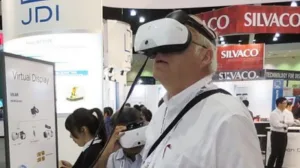BOE was showing three different HMDs in their booth on the show floor. Two of the units were designed around two LTPS 3.5” displays (one per eye); with both displays running at a 90Hz frame rate; with a 100° FOV; and a latency time of <20mS. One unit had 2160 x 2376 resolution per eye (917PPI) and the other had 1440 x 1600 resolution per eye (615PPI). This works out to about 2.5 arc-minutes/pixel for the high resolution version and 3.8 arc-minutes/pixel for the lower resolution version, respectable numbers but still not quite reaching the 1.0 arc-minutes the human eye can resolve. The third unit was lower performance and both eyes shared a single 5.7” UHD (3840 x 2160; 773PPI) display running at 75Hz. With a 110° FOV, this works out to about 3.4 arc-minutes/pixel.
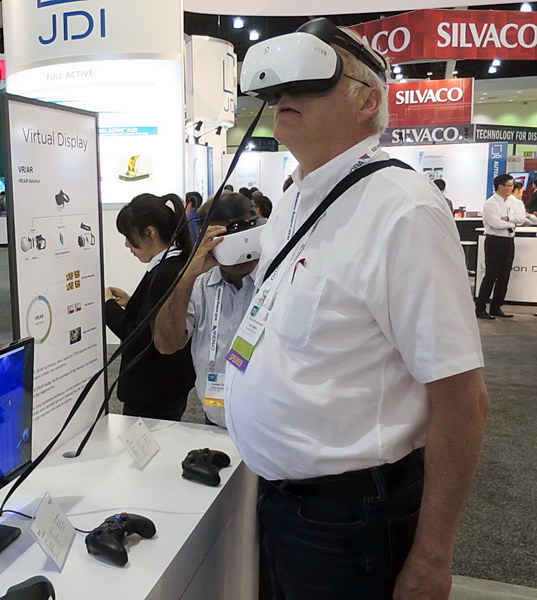 Meko’s Matt Brennesholtz tests the BOE HMD with 2160 x 2376 resolution per eye and a 90Hz frame rate. The image looked very good and had low latency. (Photo Credit: M. Brennesholtz)
Meko’s Matt Brennesholtz tests the BOE HMD with 2160 x 2376 resolution per eye and a 90Hz frame rate. The image looked very good and had low latency. (Photo Credit: M. Brennesholtz)
Llvision was showing their Glxss Pro system on the show floor. This is a professional look-around HMD mounted on an eyeglass-type frame but with no eyeglasses. It has a 21° FOV and the image is generated by a 640 x 480 OLED microdisplay. There is a 13Mpixel Sony Exmor RS CMOS 1080p camera said to be suited for recording and broadcasting applications. The HMD includes both microphone and speakers and weights only 33.6g. According to Llvision, this is the world’s lightest.
The head-worn unit is connected to its host by a USB-3 Type-C cable. The host has it’s own display, a 5” 1280 x 720 LCD. The host processor is an Intel Atom Z8350 quad-core 1.92GHz processor with a Intel HD Graphics Gen 8 12EU 500MHz GPU. The host contains a 5800mAh interchangeable battery, GPS and Wi-Fi.
Applications targeted by the Glxss Pro system include remote coaching, mobile surveillance and telemedicine. The unit is available now for about $1700 for the HMD and host processor.
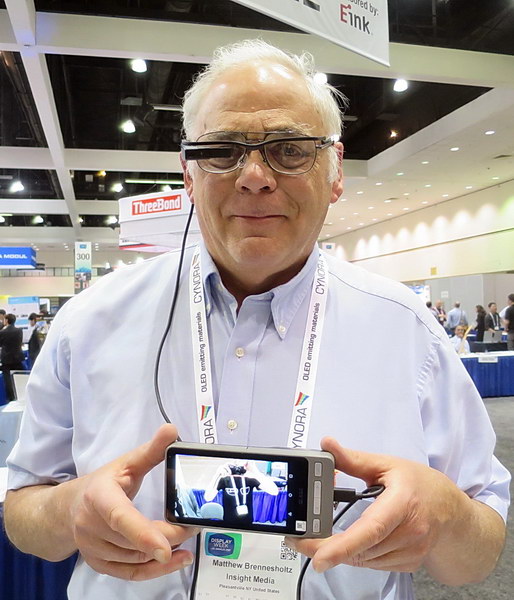 Meko’s Matt Brennesholtz wearing Llvision’s Glxss Pro over his regular glasses and holding the host control unit which is showing the image captured by the camera. This image includes Llvision’s rep taking the photo. (Photo Credit: M. Brennesholtz)
Meko’s Matt Brennesholtz wearing Llvision’s Glxss Pro over his regular glasses and holding the host control unit which is showing the image captured by the camera. This image includes Llvision’s rep taking the photo. (Photo Credit: M. Brennesholtz)
The School of Electronics and Information Technology at Sun Yat-Sen University had a booth in the I-Zone and the students were showing off their experimental light-field, 3D HMD glasses. These glasses are designed to show the objects in the 3D image at the correct distance so there would be no vergence/accommodation conflict. This light-field effect could be turned on and off to show the image with and without a vergence/accommodation conflict. Unfortunately, when you get to be my age, your eyes don’t have any accommodation anyway, so I couldn’t see any difference with the light field on or off. (I tried it and couldn’t see much difference, either, but I’m also of ‘a certain age’ – Man. Ed.)
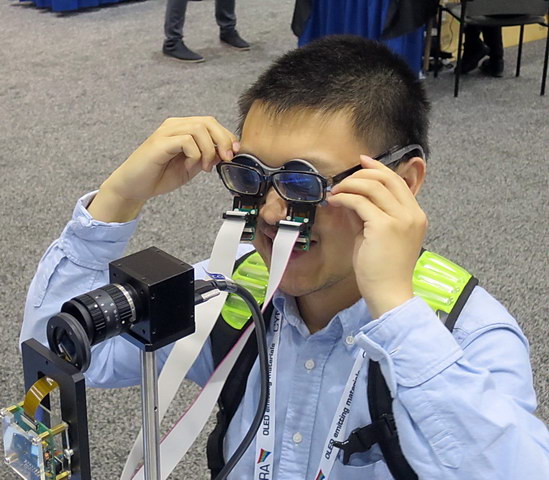 Visitor to the I-Zone testing Sun Yat-Sen Universities experimental light-field glasses. (Photo credit: M. Brennesholtz)
Visitor to the I-Zone testing Sun Yat-Sen Universities experimental light-field glasses. (Photo credit: M. Brennesholtz)
Samsung was showing off two AMOLED VR HMDs in their exhibition booth on the show floor along with their other AMOLED products. There was no explanation along with the HMDs other than the two units were both based on 3.5” displays with, presumably, one display per eye. The low resolution panel was 1080 x 1200 pixels (460PPI) while the high resolution panel was 2024 x 2200 pixels (858PPI). Both panels had 100 cd/m² brightness and ran at 90Hz frame rate. Without knowing the FOV of the HMD, it is not possible to estimate the arc-minutes/pixel value.
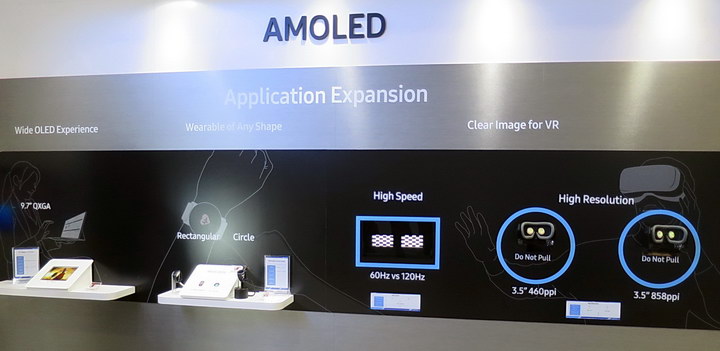 AMOLED HMDs and other AMOLED products from Samsung (Photo Credit: M. Brennesholtz.
AMOLED HMDs and other AMOLED products from Samsung (Photo Credit: M. Brennesholtz.
-Matthew Brennesholtz

